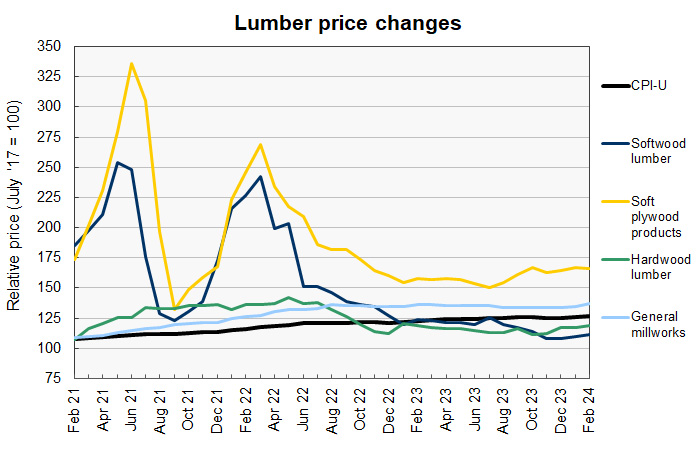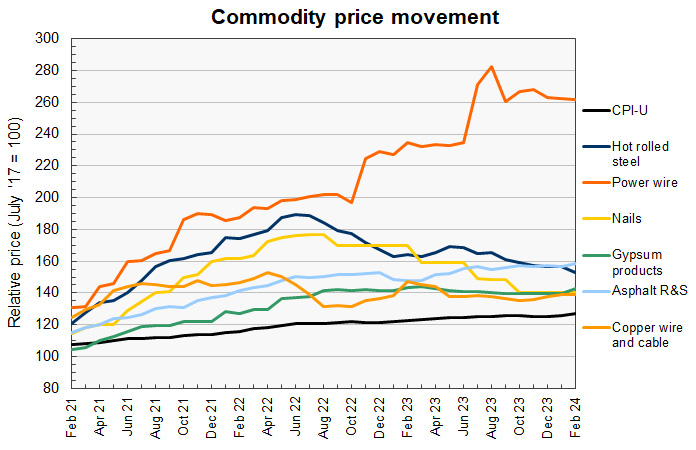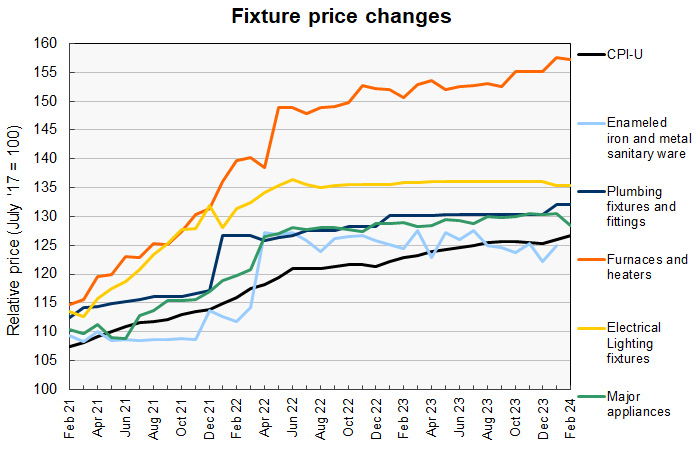The producer price index (PPI) report from the Bureau of Labor Statistics (BLS) stated that construction materials prices were up 0.3 percent month-over-month in February on a seasonally adjusted basis. The index of components and materials for construction was up 1.8 percent from its year-earlier level, up from the 1.4 percent year-over-year rise reported last month.
Overall prices for processed goods for intermediate demand were up 1.6 percent for the month. Last month’s fall in the prices of processed fuels and lubricants reversed this month, with prices jumping 6.2 percent. The processed goods for intermediate demand index was 1.8 percent lower than its year-earlier level.
For reference, the changes in these indices compare with a 3.2 percent rise in the all-items consumer price index (CPI-U) for the 12 months ending in February. The seasonally adjusted February CPI-U was up 0.4 percent from January’s level. Consumer energy prices were up 2.3 percent for the month but down 1.9 percent year-over-year. The shelter portion of the CPI-U was up 0.4 percent for the month and was 5.7 percent higher than its year-ago level. Seasonally adjusted rent of primary residence was up 0.5 percent for the month and 5.8 percent for the year.
Yield Pro compiled the BLS reported changes for our standard list of construction materials prices. These are prices of materials which directly impact the cost of constructing an apartment building. The first two right hand columns of the table provide the percent change in the price of the commodity from a year earlier (12 Mo PC Change) and the percent change in price from January (1 Mo PC Change). If no price data is available for a given commodity, the change is listed as N/A.
The pre-COVID column lists the change in the current construction materials prices relative to the average of prices from December 2019 through February 2020, before the pandemic impacted the economy. This provides a longer-term view of construction materials price trends.
| Commodity | 12 Mo PC Change | 1 Mo PC Change | Pre-covid Change |
| Softwood lumber | (10.2) | 1.7 | 11.3 |
| Hardwood lumber | 0.5 | 1.5 | 30.7 |
| General millworks | 0.5 | 2.1 | 31.2 |
| Soft plywood products | 5.0 | (0.4) | 79.3 |
| Hot rolled steel bars, plates and structural shapes | (6.8) | (2.1) | 47.8 |
| Copper wire and cable | (5.4) | (0.1) | 30.7 |
| Power wire and cable | 11.4 | (0.3) | 124.8 |
| Builder’s hardware | (1.0) | 0.0 | 24.1 |
| Plumbing fixtures and fittings | 1.4 | 0.0 | 19.3 |
| Enameled iron and metal sanitary ware | N/A | N/A | N/A |
| Furnaces and heaters | 4.4 | (0.2) | 38.5 |
| Sheet metal products | 2.3 | 0.7 | 47.2 |
| Electrical Lighting fixtures | (0.4) | 0.0 | 17.6 |
| Nails | (17.3) | (0.2) | 23.1 |
| Major appliances | (0.3) | (1.5) | 20.9 |
| Flat glass | N/A | N/A | N/A |
| Ready mix concrete | 7.4 | 0.3 | 34.5 |
| Asphalt roofing and siding | 7.1 | 1.1 | 41.8 |
| Gypsum products | (0.2) | 2.5 | 44.2 |
| Mineral wool insulation | 1.9 | 2.4 | 44.0 |
| CPI-U unadjusted | 3.2 | 0.6 | 20.2 |
The first chart, below, shows the price index history for wood products over the past 37 months. Note that the prices used by the BLS in compiling the indexes are collected on the Tuesday of the week containing the 13th day of the month. In February that would have been February 13. In the March report, the data collection date will be March 12.

The softwood lumber price index was reported to rise by 1.7 percent in February on top of a 0.2 percent upward revision to January’s lumber price index. While still significantly lower than their year-earlier levels, softwood lumber prices have risen 3.2 percent in just the last 3 months.
Hardwood lumber prices were reported to be up 1.5 percent for the month. However, they are only marginally higher than their levels of one year ago.
The soft plywood price index was reported to fall slightly in February. However, the price index for January was revised higher by 2.6 percent so the reported soft plywood price index is 2.1 percent higher than the preliminary level reported last month.
Looking ahead, Business Insider reported that the market price of lumber closed on February 13 at $553 and rose to $575 on March 12. Softwood lumber prices have been trending higher since last October. Lumber prices in the futures markets also seem to signal upward price pressure. The May 2024 contract closed at $614 on March 12, up from $575 on February13. The July 2024 contract closed at $623 on March 12, up from $589 on February 13.
The next chart, below, shows the recent history of several other construction materials prices. These are relatively simple commodities whose prices are strongly driven by those of the materials of which they are comprised.

The price index for power wire and cable edged lower for the second consecutive month in February. It was down 0.3 percent for the month while remaining 11.4 percent higher year-over-year.
The price index for copper wire and cable moved 0.1 percent lower for the month on top of a 0.6 percent downward revision to last month’s index. The price index for hot rolled steel bars was reported to fall 2.1 percent, but this was after a +0.2 percent revision to the price index for the month before.
Looking ahead at prices for underlying materials, MarketWatch reported that the NYSE American steel index moved higher for the month. It closed at $2,048 on February 13 and closed at $2,096 on March 12. It traded as high as $2,148 between those dates. Steel futures were also higher. The May 2024 contract closed 10.0 percent higher on March 12 than it did on February 13 while the July 2024 contract closed 5.3 percent higher.
The price of copper closed at $3.93 per pound on March 12 up $0.19 since February 13. Its March 12 closing price was the high for the period since February 13. Its February 13 closing price was the low for the period.
The price of aluminum is down from our last reading. It closed on March 12 at $2,249, down $24 from its level on February 13. However, it had closed as high as $2,263 and as low as $2,180 between those dates.
Price changes for several of the more finished goods from our sample are illustrated in the final chart, below.

The construction materials prices for the commodities shown in this chart continued their pattern of relative stability. The year-over-year rise in the price index for furnaces and heaters increased to 4.4 percent despite the index falling 0.2 percent for the month. The biggest month-over-month change was a 1.5 percent drop in the price index for major appliances.
The last several articles on construction materials prices have discussed the odd behavior in the price of enameled iron and metal sanitary ware. The price index has been reported to be exactly the same each month for the last several months and variations in the index only appeared as revisions to earlier month’s data. Well, this month they did not report a price index for this commodity at all. No price index was reported for flat glass either.
The full current BLS report can be found here.












